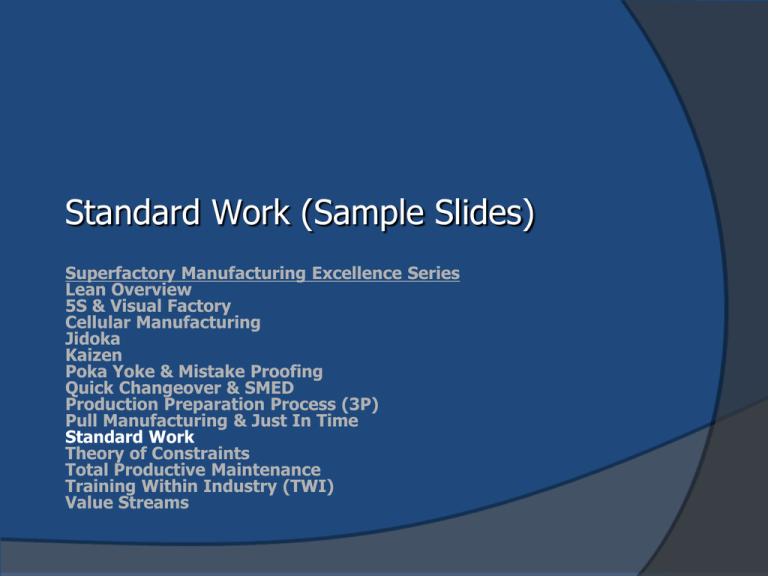
Standard Work (Sample Slides)
Superfactory Manufacturing Excellence Series
Lean Overview
5S & Visual Factory
Cellular Manufacturing
Jidoka
Kaizen
Poka Yoke & Mistake Proofing
Quick Changeover & SMED
Production Preparation Process (3P)
Pull Manufacturing & Just In Time
Standard Work
Theory of Constraints
Total Productive Maintenance
Training Within Industry (TWI)
Value Streams
Contents
•
•
•
•
Introduction
Background and History
Components and Implementation
Knowledge Check
© 2007 Superfactory™. All Rights Reserved.
2
Introduction
• Standard work is an agreed-upon set of work
procedures that establish the best and most
reliable methods and sequences for each process
and each worker.
• Standard work is a tool used to best utilize people
and machines while keeping the rhythm of
production tied to the flow of customer orders.
© 2007 Superfactory™. All Rights Reserved.
3
Components and Implementation
• Standards and Standardization
• Standard Work
–
–
–
–
Takt Time
Standard Work Sequence
Standard Work-in-Process Inventory
Four steps to Standard Work
• Sustaining Standard Work
© 2007 Superfactory™. All Rights Reserved.
4
Types of Standards
• Regulations
• Quality Standards
• Specifications
• Technical Standards
• Process Standards
• Manuals
• Notices
• Memos
© 2007 Superfactory™. All Rights Reserved.
5
Standard Work
• Standard work consists of three elements:
– Takt time
Matches the time to produce a part or finished product
with the rate of sales. It is the basis for determining
workforce size and work allocation
– Standard work sequence
The order in which a worker performs tasks for various
processes
– Standard in-process inventory
The minimum number of parts, including units in
machines, required to keep a cell or process moving
• Once a standard work is set, performance is
measured and continuously improved
© 2007 Superfactory™. All Rights Reserved.
6
Step 4: Standard Work Sheet
• Create a drawing of the operations in the cell
and enter their sequence and description
• Enter the quality checkpoints
• Enter the safety checkpoints
• Enter the WIP
• Enter the takt time and the net cycle time
• Enter the amount of standard WIP
• Enter the breakdown numbers to indicate different
operations in the cell and total number of
operators
© 2007 Superfactory™. All Rights Reserved.
7
Improving Standard Work
• Areas for improvement
– Flow of materials
– Shifting from specialization to multi-skilled lines and
operators
– Improvements in motion
– Establishing rules for operations
– Equipment
– Separation of people and machines
– Preventing defects
– Eliminating walking
– Shift from one-handed to two-handed tasks
– Placement of parts
• Improvements in motion are among the
most important changes
© 2007 Superfactory™. All Rights Reserved.
8
Maintaining Standard Work
• Establish standard operations throughout the
factory
• Make sure everyone understands the importance
• Trainers must be committed to the operations they
teach
• Post visual displays to remind everyone
• Post graphic and text descriptions
• Reject the status quo
• Conduct group improvement activities regularly
• Systematically pursue improvements in standard
work
© 2007 Superfactory™. All Rights Reserved.
9












